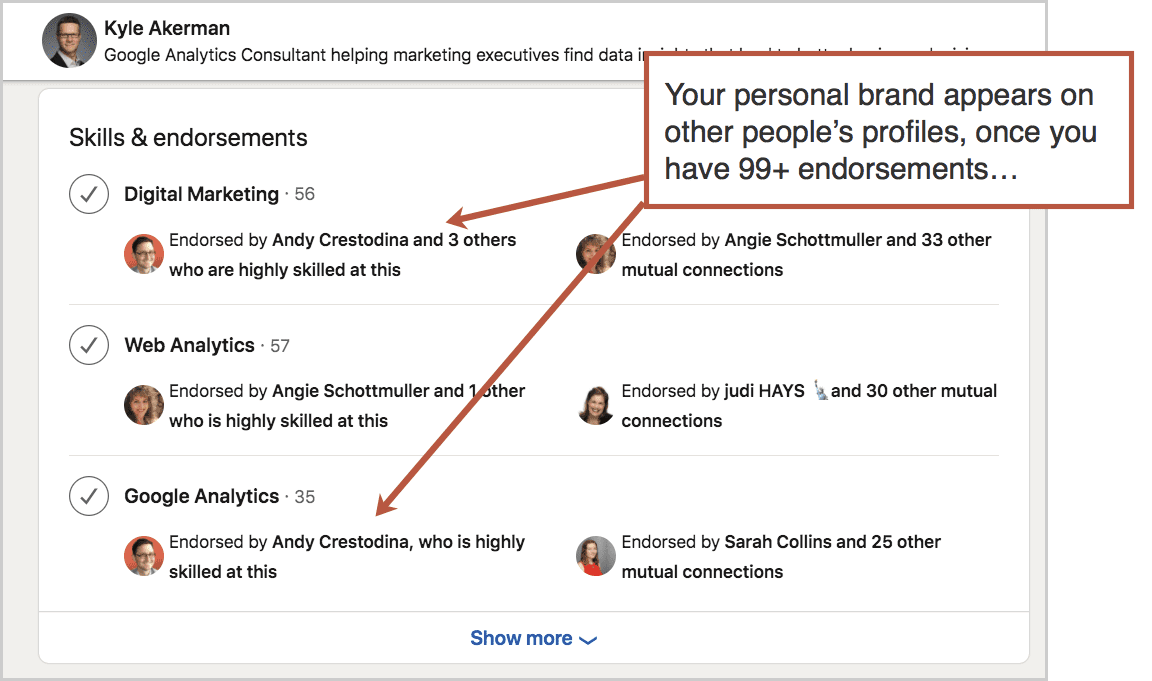Googled yourself lately? Take a minute. Open a new tab. Search for yourself.
This is your personal brand in SERPs (Search Engine Results Pages).
Do you like what you see?
If you’d like that search results page to look a bit better, this post is for you. This detailed breakdown shows how to improve your personal brand. This is all about managing the search results page for your own name.
You’ll learn the following:
- How to create the biggest possible digital footprint for yourself
- How to manage your online reputation and push negative press off the first page of search results
- How to better control your personal brand
Note: Got a common name? You’re not alone. If you see a ton of noise (other people) when you search for yourself, just do what someone searching for you would do: add the name of your city or company and search again.
Step 1: Search optimize the bio on your own site
This is the digital property that you own. Your bio on your company site (or personal site) is the easiest to manage and optimize. Unlike social media profiles, you control this page completely.
Ideally, this page ranks #1 for your name.
If a social media website is outranking your on-site bio for your name, you should improve your bio until it is a more detailed, useful page than the social profiles that outrank it.
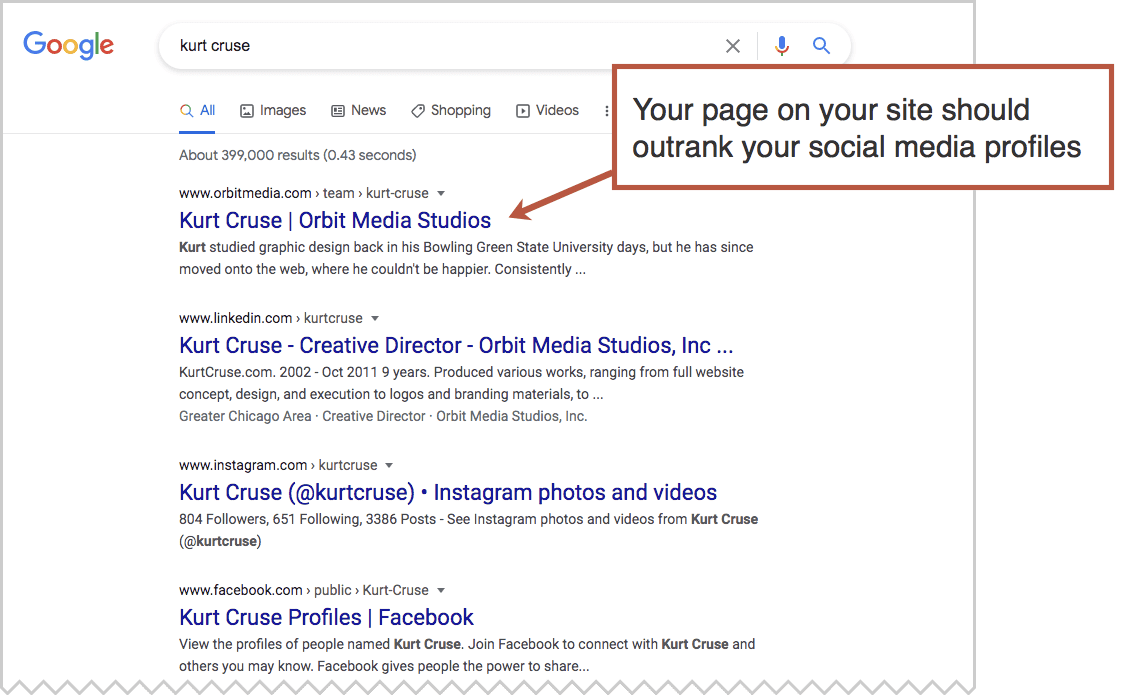
This means adding a lot of information. It can be credentials of course, but also can include personal stories, interests and anecdotes. It can include video and other media, and of course, links to social media platforms where you are active.
Warning: If your website has one page with the entire team (without a bio page for each team member) OR if it has popup windows or expandable content areas with detailed bios (rather than a page with a unique URL for each person) then you’ve got bigger problems. Your site has an inherent SEO disadvantage.
Great websites have a page for each person. And these bio pages align with SEO best practices: they include relevant keyphrases, they have meaningful meta descriptions and they can even attract links.
It’s these bio pages that should rank #1 for each person’s name.
“What people see when they google your name is your new business card. It is up to you to make your Personal Brand SERP positive, accurate and convincing to your audience.” Jason Barnard, Kalicube
Step 2: Add schema markup to that new bio
Beyond a great read for visitors, bios have a technical SEO opportunity that will help you inject a bit of your data into the search engine. It’s called “schema” or microdata.
What’s schema?
Schema is a standard for special HTML tags (structured metadata) that indicate relationships between types of information. They’re little tags you put around content that gives information about the content, helping search engines understand what they’re reading.
There are all kinds of schema tags that are relevant to people and can be added to a person’s bio. Here is a list of the 20 or so that are likely the most relevant to most people.
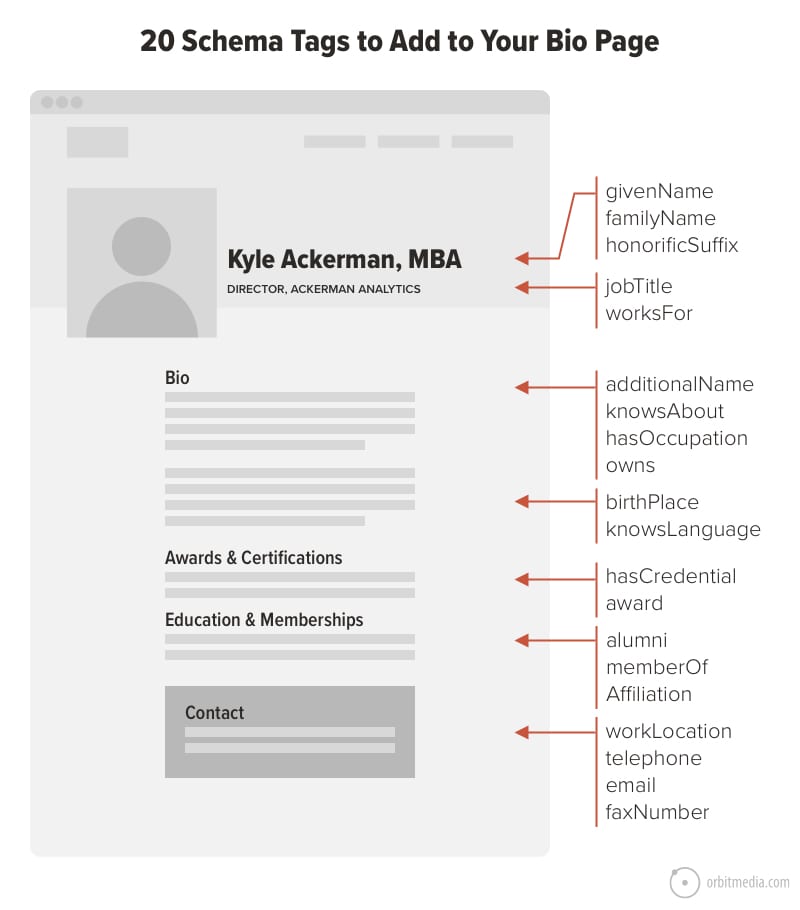
Contact your web developer if you need help adding schema to your bio pages. Once done, you can check their work by running the page through Google’s Rich Results Test tool. It will show which schema will be correctly parsed by a search engine.
Here’s an example report showing a bio page with proper markup:
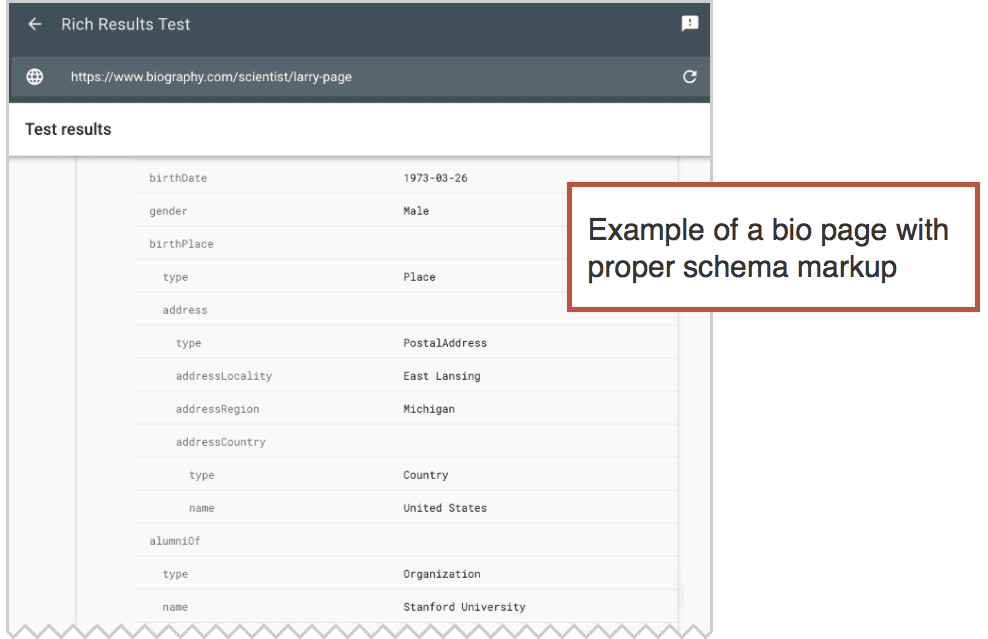
And here’s what it looks like when a search engine interprets the schema-tagged content and created a richer search engine results page (SERP):
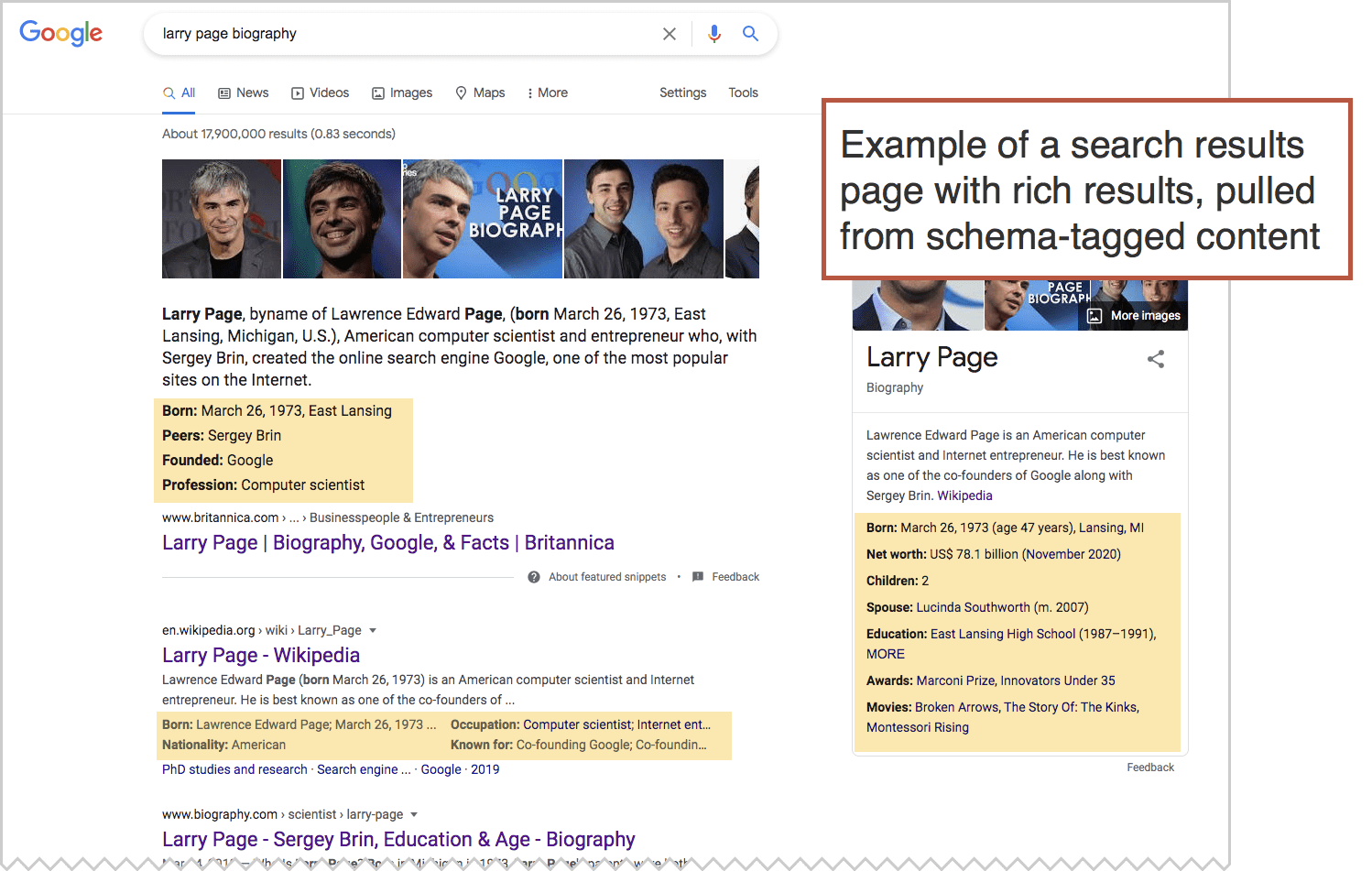
There is, of course, no guarantee that the search engine will show rich snippets once the data is tagged, but add the content and schema tags anyway. The SEOs job is to help search engines do their job, right?
Step 3: Make your LinkedIn profile sparkle
Does your LinkedIn profile rank for your name? Probably, yes. For this reason, polishing your professional profile on LinkedIn is an important extension of your personal brand. Google is naturally going to send people in that direction.
Improving your profile will also improve your rankings for relevant keywords within LinkedIn. That’s SEO too, right? Even if you’re not a job seeker today, it will be good for future job searches if your profile ranks when hiring managers search LinkedIn.
Start with a professional headshot. This is a key personal branding asset. Here is our best advice for social media profile pictures, including tips for what color to wear on picture day.
Beyond that, let’s get some tips from personal branding expert, Heather Bennett. Here are her 8 quick tips for improving your LinkedIn profile:
- Update your banner with photos, seals of accredited organizations, credentials (images of an organization’s logo or seal), your website/recent publication/primary product.
- Customize your Linkedin profile url by clicking the edit button in the top right of your profile page.
- Improve your headline by applying a few of these LinkedIn headline best practices. Makes a huge difference.
- If you have a common name, add your middle name or initial. Adding your professional title (Dr., Esquire, Professor) will also differentiate your name from others that are similar.
- Answer the questions of your target audience (clients, recruiters, collaborators or a potential employer) in your About section.
- Write a detailed description for your current position. Don’t make it an “about us” paragraph for your company. Write 5 sentences that describe the value you add. Pay close attention to verbs.
- Update as often as needed. As my friends at Orbit Media say, “Digital Ink is never dry.” If you have new news or need to create a temporary banner to create excitement for an event or new product/service, go ahead and make the changes. You can update after the information is no longer relevant.
- Manage and grow your endorsements. Fill in all 50 skills and set the top 3 based on the needs of your business. Remember, those top three endorsements are the most visible. And then get those numbers up, ideally to 99+. It will take some outreach. It’s worth it.
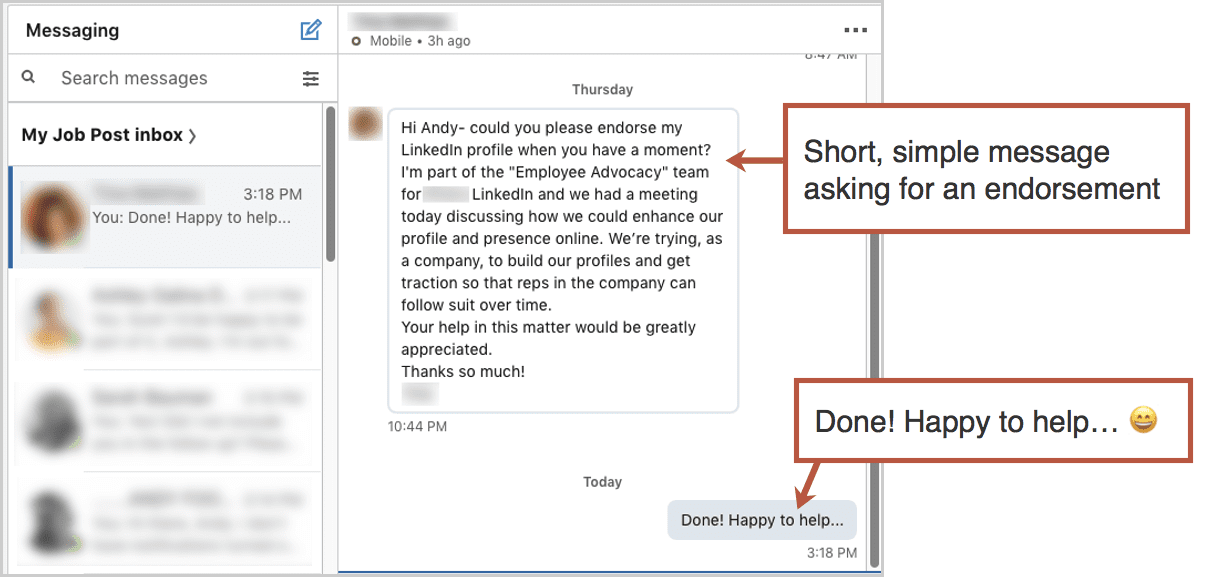
Once you have 99+ endorsements for a skill, you suddenly become much more visible on other people’s profiles.
Step 4: Claim all of your other social media profiles
LinkedIn is done. Now you can move on to all of the other social media networks.
This is powerful because social media profiles tend to rank well for names. And when that social profile ranks, that’s one less spot for something you don’t want to appear in search results: the embarrassing high school sports article, the arrest, the divorce, or just something from a past career.
You’re moving on.
So claiming social profiles is a way to push down negative press, getting it off of page one and into the past where it belongs.
I am not suggesting that you become active on every social network.
This is about SEO, not social media. No need to spend 4 hours per sharing and engaging on a social platform to get your profile to rank for your name.
Just claim the profile. Use your real name. Add your city and your company or industry. And use the same headshot picture for all accounts.
You’re not going to be active on that network? No problem. Just create one post with a link to a social network where you are active. Here’s what that looks like…
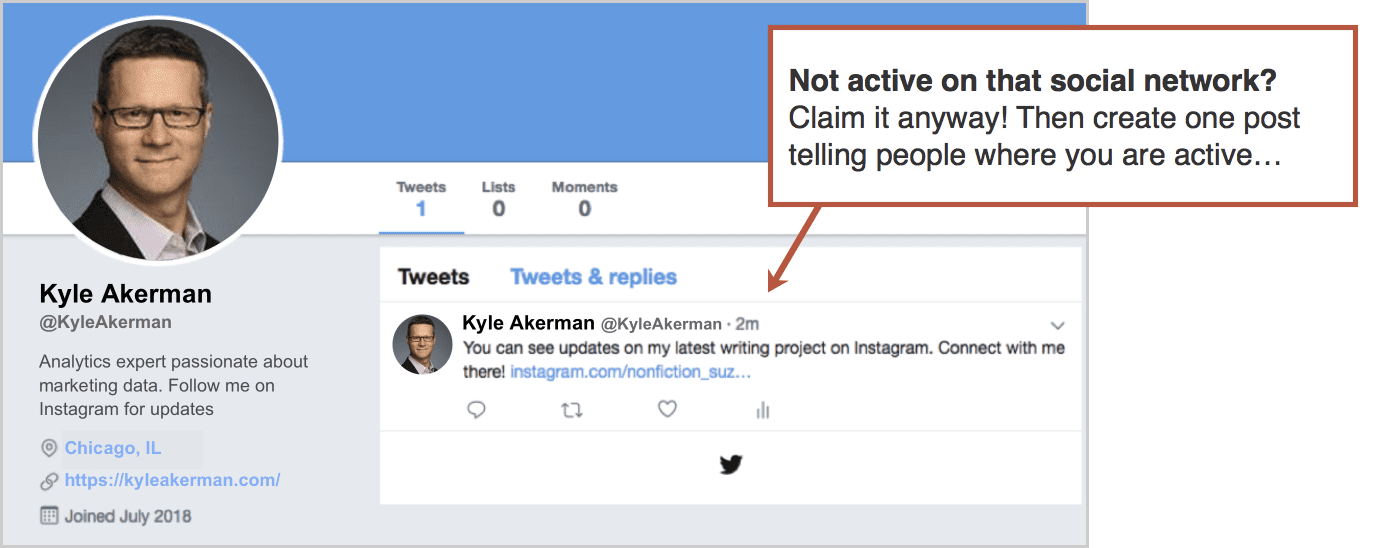
This is the proper way to ignore a social media network. Now the pressure is off, so you can go claim your profile on all of the following networks.
- Twitter
These profiles often rank very well. If you are active, there’s a chance that Google will add your tweets right into search results. - Facebook
Facebook profiles often rank for names. Although your Facebook profile may not be relevant to your job, make sure your profile picture isn’t unprofessional. Depending on your privacy settings, a lot of people may see it. Also, claim your vanity URL. - Pinterest
Profiles here often appear in Google search results. If you are active here and would prefer to keep this personal, go to the Privacy Settings and click “Hide your profile from search engines.” - YouTube
If you have an account that is more personal than professional, you can consider creating a second account, simply for your personal brand and reputation management reasons. - Vimeo
Along with YouTube, profile pages on Vimeo rank well. Enter a bio, add a link, set your location, claim a URL and even add featured videos. - Quora
The profile pages are very simple, but they often rank! After you add your picture and short bio, follow a few people and a few topics. Following topics will indicate to visitors what your interests are. - Flickr
This is the only photo site that gets traction in SEO. Profiles include all the basic information, such as a profile picture, location, bio and link. - Reddit
Reddit user pages are indexed by Google. So this is another place you can create a profile. But bad news if you’re a troll: you’ll need to use your real name. - Tumblr
By default, Tumblr accounts are set up at subdomains, so grab yourname.tumblr.com, if possible. The bio page is open HTML so add anything and everything. - About.me
It’s just a simple page that links to your other profiles, but these show up in search results. Grab it. Upload a nice background photo and set up the links. If possible, use a URL that includes your name, such as about.me/yourname. - Medium
You can create a profile, even if you don’t post content to Medium. But it’s far better if you do…
Jayson DeMers knows a bit about personal branding and SEO. He writes for many of the biggest blogs on the web.
 |
Jayson DeMers, EmailAnalytics“Building your personal brand is all about publishing content — whether that content is text-based, (such as through your blog), audio-based (such as through a podcast), or video-based (such as through a Youtube channel). To stand out, your content needs to be unique or provide significant value that keeps your audience coming back for more. Keep with it and your personal brand will grow over time!” |
Step 5: Advanced personal branding for influencers
I’m adding this section for authors, speakers and professional influencers, who have been active in thought leadership marketing for a while.
Claim your knowledge panel.
If a “knowledge panel” appears on the right side of the search results when you search for your name, that’s great. You’ve given Google many reasons to believe that you are a real person and the search engine is beginning to connect the dots.
Claiming this knowledge panel takes just a few clicks. During that process, you’ll be given the opportunity to enter your official social media accounts.
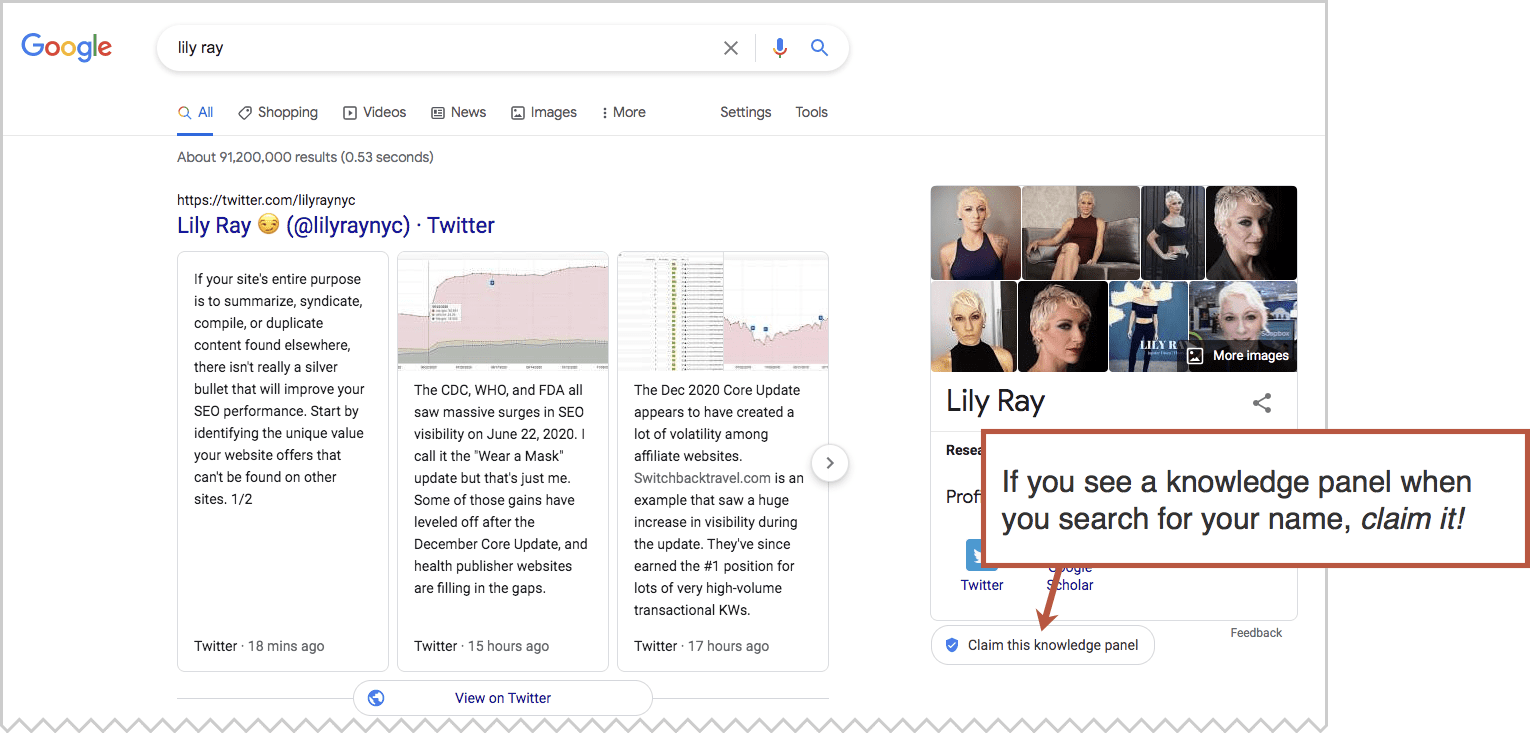
Set up your Amazon Author Page.
This is one of the many SEO benefits of being an author. Once you’ve published, go ahead and complete your account at Amazon Author Central. Add your bio, post updates, upload a video, make it shine. For some authors, Amazon is a place for their personal blog.
Put your name in the title of some YouTube videos.
If you can get videos to appear in these search results, you are on the fast track to trust and thought leadership. Searchers can see your face and hear your voice with a single click.
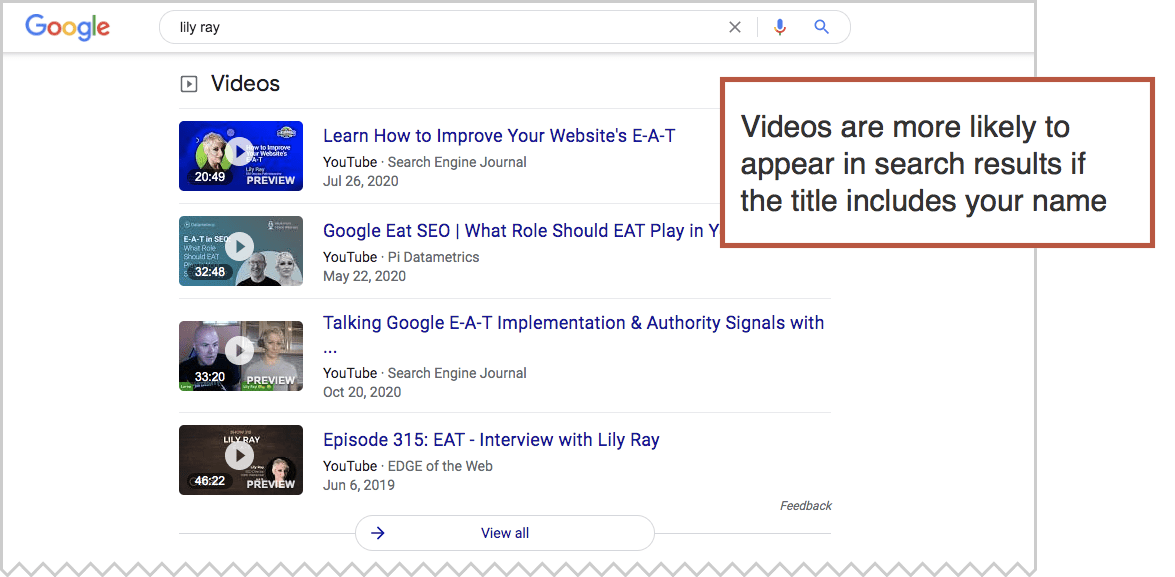
When mentioned on other sites, turn social media links into backlinks.
When your name appears in someone’s content, it’s often a clickable link. If that link goes to a social profile, there is no specific SEO benefit. But if that link is to the bio on your site, it can help the rankings of your bio …and the overall Domain Authority / ranking potential of every page on your site.
Reaching out to bloggers and editors to ask them to update a link is called link reclamation and it’s the easiest link building opportunity there is.
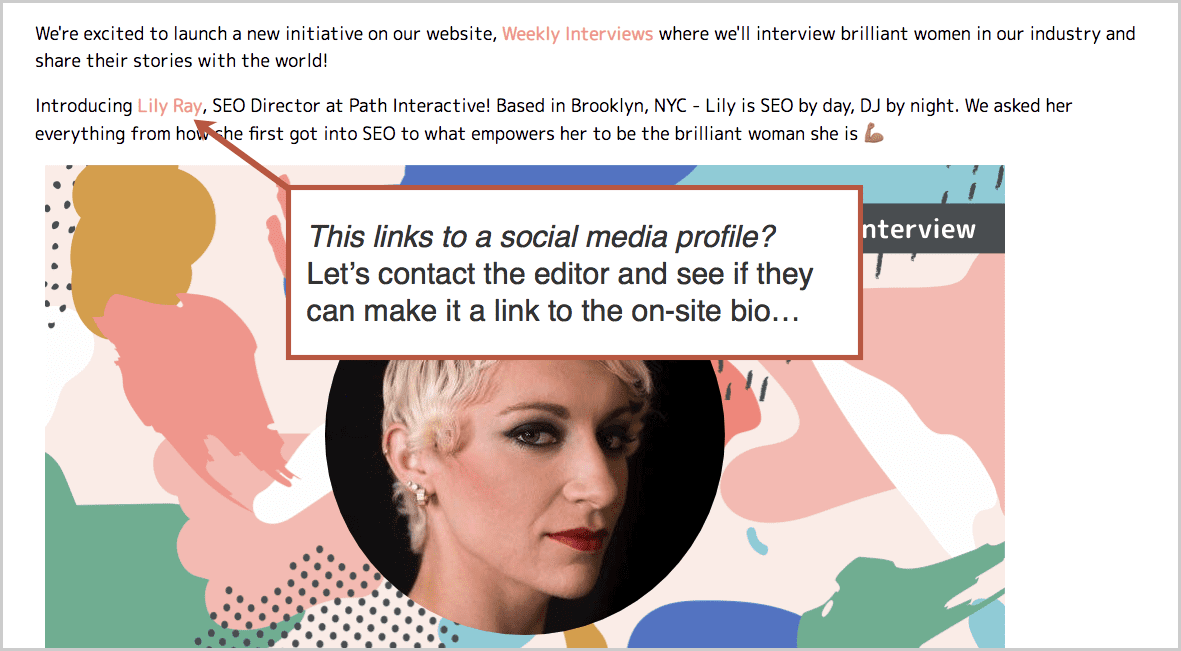
Set up your Google Scholar account.
You’ve been publishing for a while and academics have mentioned your work. Google has found these and lists them as citations in the Google Scholar program.
It’s a simple three-step process, during which you can enter your interests, your homepage or bio page and even manually add articles.

Have a big digital footprint
Search engines (and social networks) are trying hard to better understand who is out there, who you are, what you’ve done.
Connecting the dots – your profiles, your work and yourself – helps them with attribution, helps them fight fake news and ultimately, it helps people find you.
SEO for individuals, like most efforts in search optimization, is really just about helping people find what they’re looking for. In this case, that’s you.
Let’s go back to Heather for the final word on personal branding:
 |
Heather Bennett, Author of Fun and Fulfilling Careers One Question At a Time“The keys to a great personal brand are authenticity, consistency, clear communication and awareness of the audience and their needs. A personal brand should be consistent in all forms of communication from digital (social media profiles, emails, websites) to in person (business cards, presentations, elevator speeches at networking events). Taking time to clearly define, target, and share your personal brand will lead to career success.” |

